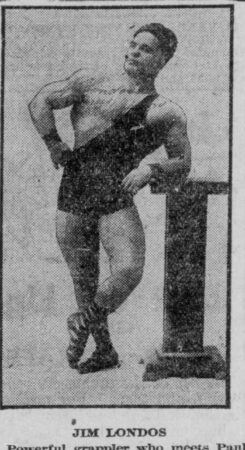Jim Londos gör avtryck
In the early 1920s, Christos Theofilou började brottas som Jim Londos efter flera år som jippon “Brottning putsare”. Londos insåg förmodligen inte att namnbytet skulle vara det första steget till att han skulle bli den största kassaattraktionen inom 1930-talets professionella brottning.
Det andra steget var hans framträdande som huvudbrottare i St. Louis. Born in Greece before emigrating to the United States, John Contos began promoting professional wrestling in 1922. Whether Contos was motivated to help a fellow countryman or he saw Londos’ potential as a box office draw, Londos was quickly Contos’ top local wrestler.

Jim Londos från november 16, 1920 utgåva av Idaho Statesman (Public Domain)
Although already 28 år gammal i 1922, Londos possessed a bodybuilder’s physique and wrestling skills developed when he worked for the carnivals. Londos would always be considered a performer but he did have some legitimate wrestling skill. George Tragos wouldn’t let Lou Thesz wrestle Londos early in Thesz’s career for fear Londos would try to hurt the up-and-comer.
I januari 1923, Och “Strangler” Lewis came to town to defend his championship against Govani Tiverio. Londos would be wrestling in the co-main event. Contos was building to a Lewis-Londos match for the title in St. Louis. Contos was sure the matchup would draw a large crowd.
When Londos became World Champion in the early 1930s, he wouldn’t wrestle Lewis unless Lewis put up a $25,000 forfeit. If Lewis double-crossed Londos and took the title legitimately, Londos would receive the $25,000. Londos was terrified of wrestling a contest with Lewis.
Emellertid, Londos was quite content to work with Lewis, when Lewis was World Champion. A match with Lewis always generated more money at the gate and a bigger payoff for both wrestlers.
It was a good night in January for both Lewis and Londos. Both men won their matches in two straight falls. Londos defeated Jack McCarthy with a “Japanese arm bar”, which he reportedly learned from a Japanese ju-jitsu expert.
Londos did wrestled Lewis for the title in St. Louis on February 20, 1923. It was their second title match in St. Louis. 10,000 fans braved the winter weather to make their way to the St. Louis Coliseum for the match. 10,000 fans was a huge crowd at any time of the year.
Lewis won the first fall after an hour and 46 minutes of wrestling. He needed 11 headlocks to wear Londos down to win the first fall.
Londos won the second fall in 13 minuter, 15 seconds with his Japanese arm bar. With the match tied one fall apiece, fans were sitting on the edge of their seat for the third fall.
Lewis and Londos used an injury angle to make Londos look strong even in defeat. As the third fall began, Londos took the offensive and brought Lewis to mat repeatedly with versions of the arm bar. Lewis kept putting his feet in the ropes to cause a break.
While the men were standing by the ropes, Lewis went for a headlock but Londos slipped out of it. Although he escaped Lewis’ hold, Londos’ momentum took him through the ropes. Londos struck his left shoulder on the ring apron and appeared injured.
Londos climbed back in the ring without using his left arm and tried to avoid Lewis as his left arm hung at his side. Lewis didn’t immediately attack the arm but applied several headlocks. As Londos appeared groggy, Lewis secured a hammerlock causing Londos to immediately concede in great pain.
Lewis left as champion but Londos could always claim that if it wasn’t for the injury he could have beaten Lewis. The Gold Dust Trio often employed an injury angle for the benefit of both wrestlers and future rematches.
Londos didn’t need much help because he was so over with the St. Louis fans. Londos was back in the main event for the March 1923 card. Londos was so popular that local businessmen pledged to spend $100,000 for a state-of-the-art gymnasium for Londos to train in. Londos could operate it as a commercial gym and keep the profits as well. It would take a lot more than a close loss to diminish Londos in St. Louis.
You can leave a comment or ask a question about this or any post on my Facebook-sida.
Sources: St. Louis Star and Times, Januari 17, 1923 edition, p. 16, Januari 18, 1923 edition, p. 16 and February 21, 1923 edition, p. 16

